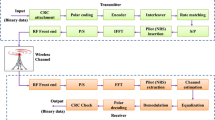Abstract
We proposed new solutions for distributed realization of the quasi orthogonal space-time block coding (QOSTBC), which is designed for 8 × 1 multiple input–single output (MISO) system. The first proposed solution assumes that base station and relay stations are equipped with 2 antennas, while for the second solution base station is equipped with 4 antennas and relay stations are with one antenna. In both scenarios mobile unit is equipped with single antenna. The proposed solutions are compared with distributed QOSTBC which is used for 4 × 1 MISO system. The simulation results show BER performances improvements provided with the proposed solutions in comparison with distributed QOSTBC designed for 4 × 1 MISO. It was shown that the first proposed scheme provides lower BER values than the second solution. Also, beside ideal channel estimation, influence of real estimation errors on BER performances is considered.








Similar content being viewed by others
References
Gozalvez, J. (2016). New 3GPP standard for IoT [mobile radio]. IEEE Vehicular Technology Magazine, 11(1), 14–20.
Kaur, N., & Sood, S. K. (2017). An energy-efficient architecture for the Internet of Things (IoT). IEEE Systems Journal, 11(2), 796–805.
Sulyman, A. I., Oteafy, S. M. A., & Hassanein, H. S. (2017). Expanding the cellular-IoT umbrella: An architectural approach. IEEE Wireless Communications, 24(3), 66–71.
Beyene, Y. D., Tirkkonen, R. J. O., Ruttik, K., Iraji, S., Larmo, A., Tirronen, T., et al. (2017). NB-IoT technology overview and experience from cloud-RAN implementation. IEEE Wireless Communications, 24(3), 26–32.
Wallace, K., Moran, K., Novak, E., Zhou, G., & Sun, K. (2016). Toward sensor-based random number generation for mobile and IoT devices. IEEE Internet of Things Journal, 3(6), 1189–1201.
Hossain, M. S., Xu, C., Li, Y., Pathan, A. K., Bilbao, J., Zeng, W., et al. (2017). Impact of next-generation mobile technologies on IoT-cloud convergence. IEEE Communications Magazine, 55(1), 18–19.
Urosevic, U., Veljovic, Z., & Pejanovic-Djurisic, M. (2013). MIMO solution for performance improvements of OFDM–CDMA system with pilot tone. Wireless Networks, 19(8), 2021–2028.
Kim, Y., Ji, H., Lee, J., Nam, Y., Ng, B., Tzanidis, I., et al. (2014). Full dimension MIMO (FD-MIMO): The next evolution of MIMO in LTE systems. IEEE Wireless Communications, 21(2), 26–33.
Prasad, K. N. R. S. V., Hossain, E., & Bhargava, V. K. (2017). Energy efficiency in massive MIMO-based 5G networks: Opportunities and challenges. IEEE Wireless Communications, 24(3), 86–94.
Ai, B., Guan, K., He, R., Li, J., Li, G., He, D., et al. (2017). On indoor millimeter wave massive MIMO channels: Measurement and simulation. IEEE Journal on Selected Areas in Communications, 35(7), 1678–1690.
Chen, X., & Zhang, Y. (2017). Mode selection in MU-MIMO downlink networks: A physical-layer security perspective. IEEE Systems Journal, 11(2), 1128–1136.
Lozano, A., & Jindal, N. (2010). Transmit diversity vs. spatial multiplexing in modern MIMO systems. IEEE Transactions on Wireless Communications, 9(1). doi:10.1109/TWC.2010.01.081381.
Woong, C. (2011). Performance of amplify-and-forward cooperative networks with differential unitary space time coding. Wireless Networks, 17(3), 621–627.
Lu, X., Ni, Q., Li, W., & Zhang, H. (2017). Dynamic user grouping and joint resource allocation with multi-cell cooperation for uplink virtual MIMO systems. IEEE Transactions on Wireless Communications, 16(6), 3854–3869.
Zhang, M., Wen, M., Cheng, X., & Yang, L. (2012). A dual-hop virtual MIMO architecture based on hybrid differential spatial modulation. IEEE Transactions on Vehicular Technology, 61(6), 2586–2598.
Lee, S. H., Shin, D. R., Jeong, H. W., & Kim, Y. H. (2016). Distributed bargaining strategy for downlink virtual MIMO with device-to-device communication. IEEE Transactions on Communications, 64(4), 1503–1516.
Park, J., & Lee, S. (2012). Distributed MIMO ad-hoc networks: Link scheduling, power allocation, and cooperative beamforming. IEEE Transactions on Vehicular Technology, 61(6), 2586–2598.
Wang, D., Wang, J., You, X., Wang, Y., Chen, M., & Hou, X. (2013). Spectral efficiency of distributed MIMO systems. IEEE Journal on Selected Areas in Communications, 31(10), 2112–2127.
Truong, K. T., Sartori, P., & Heath, R. W. (2013). Cooperative algorithms for MIMO amplify-and-forward relay networks. IEEE Transactions on Signal Processing, 61(5), 1272–1287.
Urosevic, U., & Veljovic, Z. (2016). Improving BER performance of virtual QOSTBC. Wireless Networks, 8, 2649–2657.
Veljovic, Z., & Urosevic, U. (2015). Increasing code rate of the cooperative relaying with virtual OSTBC. Wireless Personal Communications, 83(1), 399–410.
Urosevic, U., Veljovic, Z., & Pejanovic-Djurisic, M. (2014). A new solution for simple cooperative relaying. Wireless Personal Communications, 75(2), 1235–1250.
Yamaoka, T., Hara, Y., Fukui, N., Kuboand, H., & Yamazato, T. (2012). A simple cooperative relaying with alamouti coded transmission. IEICE Transactions on Communications, E95–B(2), 643–646.
Veljovic, Z., & Urosevic, U. (2017). New solutions for cooperative relaying implementation of OSTBC with 3/4 code rate. Wireless Personal Communications, 92(1), 51–61.
Kühn, V. (2006). Wireless communications over MIMO channels: Applications to CDMA and multiple antenna systems (pp. 283–288). Hoboken: Wiley.
Tarokh, V., Jafarkhani, H., & Calderbank, A. R. (1999). Space-time block codes from orthogonal designs. IEEE Transactions on Information Theory, 45(5), 1456–1467.
Bayer, O., & Oner, M. (2017). Joint space time block code and modulation classification for MIMO systems. IEEE Wireless Communications Letters, 6(1), 62–65.
Liu, Y., Xia, X., Zhang, Z., & Zhang, H. (2017). Distributed space-time coding based on the self-coding of RLI for full-duplex two-way relay cooperative networks. IEEE Transactions on Signal Processing, 65(12), 3036–3047.
Author information
Authors and Affiliations
Corresponding author
Rights and permissions
About this article
Cite this article
Urosevic, U., Veljovic, Z. New Solutions for Distributed Realization of 8 × 1 MISO channel with QOSTBC. Wireless Pers Commun 97, 1799–1812 (2017). https://doi.org/10.1007/s11277-017-4649-6
Published:
Issue Date:
DOI: https://doi.org/10.1007/s11277-017-4649-6




